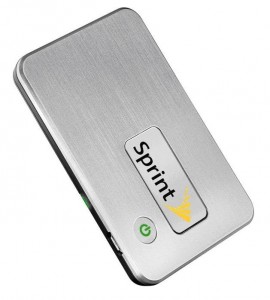 As real estate agents we have learned how to work away from our offices and to provide our services wherever the customer happens to be, at their home, their office or even at a local coffee shop.
As real estate agents we have learned how to work away from our offices and to provide our services wherever the customer happens to be, at their home, their office or even at a local coffee shop.
One of the factors that has contributed to that mobility is the nearly ubiquitous presence of WiFi. Although though WiFi may be present, in our customer’s homes it is not prudent to connect your computer to a customer’s network. The reason I say it’s not prudent is because you open yourself up to catching a virus that may be on their network, and you surely open yourself up to being accused as the cause of any future problems the customer may experience on their network after you disconnect and leave.
This is where the AirCards came into play. You purchase such a card from Sprint, Verizon, AT&T or T-Mobile, subscribe to a data plan and use the “card” with your laptop to access the cellular data networks. These work pretty well, allowing you to plug in the card, fire up the connection software and eventually open your browser or email client. If you are in a location with your client that does not have WiFi available, or if you didn’t want to use a WiFi signal that may be available, this was your only solution up until very recently.
If you wanted to share your AirCard connection with another person, this was not possible…they would need their own device, or you would have to disconnect and physically move the device to the other computer. Then install the proprietary connection software on the other computer before they could use your AirCard. When they were finished, you had to retrieve your device or risk losing it.
Enter a new breed of device called a Cellular Router. These devices allowed you to plug your AirCard into the body of the device. It then used the AirCard to establish a connection to the Internet and then it would transmit a WiFi signal to multiple nearby computers. This was a good workable solution that would solve two problems, namely working in an area without WiFi and being able to share the connection with multiple computers simultaneously.
Although it is a good solution, it requires two devices, the AirCard and the Cellular Router. You could pay upwards of several hundred dollars for the router plus the cost of the AirCard and it’s monthly data plan.
 Recently Novatel has released a credit card sized device that combines the AirCard and the Router into one device. As of this writing, it is only available on the EVDO network which is the one utilized by Verizon and Sprint in the US. Novatel has also released a model which will work on the HSPA network used by AT&T and T-Mobile, although I have not seen it on either carrier’s website as of this writing.
Recently Novatel has released a credit card sized device that combines the AirCard and the Router into one device. As of this writing, it is only available on the EVDO network which is the one utilized by Verizon and Sprint in the US. Novatel has also released a model which will work on the HSPA network used by AT&T and T-Mobile, although I have not seen it on either carrier’s website as of this writing.
After examining both Verizon’s and Sprint’s offerings via their websites, I opted to make the purchase of the Sprint unit, but bought it through http://3Gstore.com. They are authorized agents for both Verizon and Sprint and have posted reviews of both the Verizon and Sprint versions. It was their opinion that the Sprint version was the better implementation of the two (and buying the Sprint version through them was nearly $50.00 cheaper than the same thing at the Sprint website) so I purchased the Sprint one on a two year contract with a 5 GB per month data plan. Overage is billed at .05 per MB which is less than Verizon’s overage charge according to 3GStore.
So, what’s the point? For me it’s convenience. I get to carry my own private mobile hotspot that I can share with up to 4 others if I wish. It will provide WiFi to my Windows machines, my Macs, my iPhone and any other WiFi enabled device that I wish to share it with. It has a battery rated at 4 hours, can fit into a pocket or purse and does not need to be physically attached to the computer. This means that I just open my computer and connect to it’s signal as I would any other WiFi enabled hotspot. In other words, after the first time connection my computer “remembers” the device as a trusted hotspot and just connects. No fussing around with an AirCard and the connection manager software. Connection speed is a maximum throughput of 3.1Mb/s download and 1.8Mb/s upload. It is also GPS capable which will make it work with location aware websites and services. I can see this being useful with the mapping services that I tend to use.
For the security conscious among us it comes with high level security including WPA2-PSK, WEP and SPI Firewall. The User-replaceable Lithium-Ion battery provides up to four hours of run time and 40 hours standby. It’s vital stats are 3.50”x 2.32” x 0.35” and weight: 2.05 oz.
The final “kicker” for me was that with this device, my iPhone running Skype will be able to make and receive Skype calls on the Verizon network. I now have a phone that should work for me even if the AT&T network is down.
 Can you imagine using one of these at an open house? Or allowing your client to access the Internet while you are driving around in your car showing houses? I think this is another device that will streamline the way that we do business and will also be a differentiator that further divides the connected agent from the technophobes.
Can you imagine using one of these at an open house? Or allowing your client to access the Internet while you are driving around in your car showing houses? I think this is another device that will streamline the way that we do business and will also be a differentiator that further divides the connected agent from the technophobes.
Have you got one of these? If so, leave a comment and tell us how it’s working out for you.
Discover more from RealtyTechBytes.com by Jerry Kidd
Subscribe to get the latest posts sent to your email.








Leave it to the Kidd to come up with a new toy……. I like it.
Is there anything like that on a prepaid card? I checked with Verizon and it is $15.00 a day…..I really don't need a subscription contract but would love something for when we do not have an internet connection while traveling.
Janet- You are correct in that Verizon offers a "day pass", but I did not see a similar function on the Sprint website. Note that if you do not buy a 2 year contract, the price of the device rockets up to about $300.00!
Jerry how does it compare to AT&T's service?
Karen- As far as I know, this device is only offered by Sprint and Verizon. AT&T could offer it as Novatel makes one for their network, but so far they haven't done so.
I have had a Verizon air card for years, but am probably going to change to the wifi. I evidently have a good unlimited plan with Verizon so will stay with it. Can you run a printer through it?
How much is the monthly fee for the wifi aircard service?
Michael- If the printer is WiFi enabled, it should work. I don’t have any WiFi enabled printers, so I can’t check it for you.
Anne- The data fee is the same whether you use an AirCard or the MiFi router…roughly $60.00 per month.
I don’t usually comment on this stuff but I gotta say.. nice blog🙂
You are really clever!
How are the allowed users computers protected when sharing the mifi?
Hi Mary Ann-
Good question! I always advise people to make sure that they have updated all their AntiVirus definitions, kept current with Operating Systems updates and patches and otherwise been diligent about maintaining their computers before going online. Period! That holds especially true when using public WiFi hotspots such as can be found at coffee shops.
But, the MiFi uses cellular technology to connect to the Interent. Think of the MiFi as a MODEM that will allow you to share it’s Internet access. Because of that it is inherently safer than public WiFi. You can assign a password to the MiFi’s WiFi connections so that only people you give the password to will be able to access it.
For more info go to: http://budurl.com/Novatel which is the manufacturer’s spec sheet.
Best regards,
Jerry
Hi Jerry – it only took 9 months for the seed you implanted in my brain (oops .. NSFW metaphor) for me to finally get one. Love it! Sprint has 4G, but when I polled my Realtor friends which carrier is best for the Berkeley Hills, 8 out of 8 said Verizon!
So.. I’ve a Verizon MiFi card AND I’ve locked it with a password. Sharing is nice, but I want to limit access by other to my phone and iPad (yes, got the MiFi because I got the iPad – love how it work on iPhone, Mac & iPad)
I use the HECK out of my MiFi card! And I have a password on mine too. I like to share, but on my terms! 🙂 One of my students this afternoon was at the Berkeley Marina this morning for Leslie’s talk. I asked her if she saw a tall guy with beard waving an iPad around…she said yes!